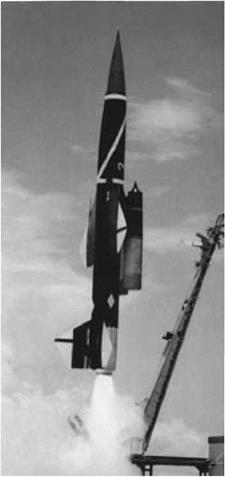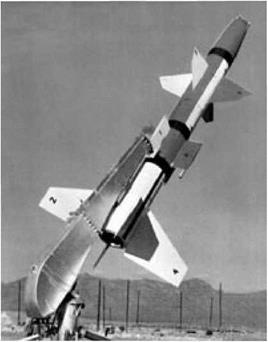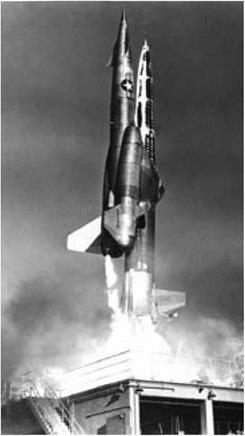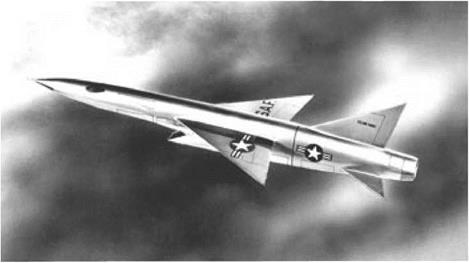Ramjets As Military Engines
The ramjet and turbojet relied on fundamentally the same thermodynamic cycle. Both achieved compression of inflowing air, heated the compressed flow by burning
|
|
fuel, and obtained thrust by allowing the hot airflow to expand through a nozzle. The turbojet achieved compression by using a rotating turbocompressor, which inevitably imposed a requirement to tap a considerable amount of power from its propulsive jet by placing the turbine within the flow. A ramjet dispensed with this turbomachinery, compressing the incoming flow by the simple method of processing it through a normal or oblique shock. This brought the promise of higher flight speed. However, a ramjet paid for this advantage by requiring an auxiliary boost, typically with a rocket, to accelerate it to speeds at which this shock could form.3
The X-7 served as a testbed for development of ramjet engines as mainstream propulsion units. With an initial concept that dated to December 1946, it took shape as a three-stage flight vehicle. The first stage, a B-29 and later a B-50 bomber, played the classic role of lifting the aircraft to useful altitudes. Such bombers also served in this fashion as mother ships for the X-l series, the X-2, and in time the X-15. For the X-7, a solid propellant rocket served as the second stage, accelerating the test aircraft to a speed high enough for sustained ramjet operation. The ramjet engine, slung beneath its fuselage, provided further acceleration along with highspeed cruise. Recovery was achieved using a parachute and a long nose spike that pierced the ground like a lance. This enabled the X-7 to remain upright, which protected the airframe and engine for possible re-use.
The X-7 craft were based at Holloman Air Force Base in New Mexico, which was an early center for missile flight test. The first flight took place in April 1951, with a ramjet of 20-inch diameter built by Wright Aeronautical. The X-7 soon took on the role of supporting developmental tests of a 28-inch engine built by the Marquardt Company and intended for use with the Bomarc missile. Flights with this 28-inch design began in December 1952 and achieved a substantial success the following April. The engine burned for some 20 seconds; the vehicle reached 59,500 feet and Mach 2.6. This exceeded the Mach 2.44 of the X-1A rocket plane in December 1953, piloted by Chuck Yeager. Significantly, although the X-7 was unpiloted, it remained aerodynamically stable during this flight. By contrast, the X – 1A lost stability and fell out of the sky, dropping 51,000 feet before Yeager brought it back under control.4
The X-7 soon became a workhorse, running off some one hundred missions between 1955 and the end of the program in July I960. It set a number of records, including range and flight time of 134 miles and 552 seconds, respectively. Its altitude mark of 106,000 feet, achieved with an airbreathing ramjet, compared with 126,200 feet for the rocket-powered X-2 research airplane.5
Other achievements involved speed. The vehicle had been built of heat-treated 4130 steel, with the initial goal being Mach 3- The program achieved this—and simply kept going. On 29 August 1957 it reached Mach 3-95 with a 28-inch Marquardt engine. Following launch from a B-50 at 33,700 feet, twin solid motors mounted beneath the wings boosted the craft to Mach 2.25. These boosters fell away; the ramjet ignited, and the vehicle began to climb at a 20-degree angle before leveling out at 54,500 feet. It then went into a very shallow dive. The engine continued to operate, as it ran for a total of 91 seconds, and acceleration continued until the craft attained its peak Mach at fuel exhaustion. It was recovered through use of its parachute and nose spike, and temperature-sensitive paints showed that it had experienced heating to more than 600°F. This heating also brought internal damage to the engine.6
Even so, the X-7 was not yet at the limit of its capabilities. Fitted with a 36-inch ramjet, again from Marquardt, it flew to Mach 4.31 on 17 April 1958. This time the drop from the B-50 came at 28,500 feet, with the engine igniting following rocket boost to Mach 1.99- It operated for 70.9 seconds, propelling the vehicle to a peak altitude of 60,000 feet. By then it was at Mach 3-5, continuing to accelerate as it transitioned to level flight. It reached its maximum Mach—and sustained a sharp drop in thrust three seconds later, apparently due to an engine tailpipe failure. Breakup of the vehicle occurred immediately afterward, with the X-7 being demolished.7
This flight set a record for airbreathing propulsion that stands to this day. Its speed of 2,881 miles per hour (mph) compares with the record for an afterburning
turbojet of 2,193 mph, set in an SR-71 in 1976.8 Moreover, while the X-7 was flying to glory, the Bomarc program that it supported was rolling toward operational deployment.
 The name “Bomarc” derives from the contractors Boeing and the Michigan Aeronautical Research Center, which conducted early studies. It was a single – stage, ground-launched antiaircraft missile that could carry a nuclear warhead. A built-in liquid-propellant rocket provided boost; it was replaced by a solid rocket in a later version. Twin ramjets sustained cruise at Mach 2.6. Range of the initial operational model was 250 miles, later extended to 440 miles.9
The name “Bomarc” derives from the contractors Boeing and the Michigan Aeronautical Research Center, which conducted early studies. It was a single – stage, ground-launched antiaircraft missile that could carry a nuclear warhead. A built-in liquid-propellant rocket provided boost; it was replaced by a solid rocket in a later version. Twin ramjets sustained cruise at Mach 2.6. Range of the initial operational model was 250 miles, later extended to 440 miles.9
Specifications for this missile were written in September 1950. In January 1951 an Air Force letter contract designated Boeing as the prime contractor, with Marquardt Aircraft winning a subcontract to build its ramjet. The development of this engine went forward rapidly. In July 1953 officials of the Air Force’s Air Materiel Command declared that work on the 28-inch engine was essentially complete.10 The Bomarc. (U. S. Air Force) Flight tests were soon under way. An
Air Force review notes that a test vehicle “traveled 70 miles in 1.5 minutes to complete a most successful test of 17 June 1954.” The missile “cruised at Mach 3+ for 15 seconds and reached an altitude of 56,000 feet.” In another flight in February 1955, it reached a peak altitude of
72,0 feet as its ramjet burned for 245 seconds. This success brought a decision to order Bomarc into production. Four more test missiles flew with their ramjets later that year, with all four scoring successes.11
Other activity turned Bomarc from a missile into a weapon system, integrating it with the electronic Semi-Automatic Ground Environment (SAGE) that controlled air defense within North America. In October 1958, Bomarcs scored a spectacular success. Controlled remotely from a SAGE center 1,500 miles away, two missiles
homed in on target drones that were more than 100 miles out to sea. The Bomarcs dived on them and made intercepts. The missiles were unarmed, but one of them actually rammed its target. A similar success occurred a year later when a Bomarc made a direct hit on a Regulus 2 supersonic target over the Gulf of Mexico. The missile first achieved operational status in September 1959- Three years later, Bomarc was in service at eight Air Force sites, with deployment of Canadian squadrons following. These missiles remained on duty until 1972.12
 Paralleling Bomarc, the Navy pursued an independent effort that developed a ship-based antiaircraft missile named Talos, after a mythical defender of the island of Crete. It took shape at a major ramjet center, the Applied Physics Laboratory (APL) of Johns Hopkins University. Like Bomarc, Talos was nuclear-capable; Jane’s gave its speed as Mach 2.5 and its range as 65 miles.
Paralleling Bomarc, the Navy pursued an independent effort that developed a ship-based antiaircraft missile named Talos, after a mythical defender of the island of Crete. It took shape at a major ramjet center, the Applied Physics Laboratory (APL) of Johns Hopkins University. Like Bomarc, Talos was nuclear-capable; Jane’s gave its speed as Mach 2.5 and its range as 65 miles.
 An initial version first flew in 1952, at New Mexico’s White Sands Missile Range. A prototype of a nuclear-capable version made its own first flight in December 1953. The Korean War had sparked development of this missile, but the war ended in mid-1953 and the urgency diminished. When the Navy selected the light cruiser USS Galveston for the first operational deployment of Talos, the conversion of this ship became a four-year task. Nevertheless, Talos finally joined the fleet in 1958, with other cruisers installing it as well. It remained in service until 1980.13
An initial version first flew in 1952, at New Mexico’s White Sands Missile Range. A prototype of a nuclear-capable version made its own first flight in December 1953. The Korean War had sparked development of this missile, but the war ended in mid-1953 and the urgency diminished. When the Navy selected the light cruiser USS Galveston for the first operational deployment of Talos, the conversion of this ship became a four-year task. Nevertheless, Talos finally joined the fleet in 1958, with other cruisers installing it as well. It remained in service until 1980.13
One military ramjet project, that of Navaho, found itself broken in mid-stride. Although the ultimate version was to have intercontinental range, the emphasis during the 1950s was on an interim model with range of 2,500 miles, with the missile cruising at Mach 2.75 and 76,800 feet. The missile used a rocket-powered booster with liquid-fueled engines built by Rocketdyne. The airplane-like Navaho mounted two 51-inch ramjets from Wright Aeronautical, which gave it the capability to demonstrate long-duration supersonic cruise under ramjet power.14
Flight tests began in November
1956,  with launches of complete missiles taking place at Cape Canaveral. The first four were flops; none even got far enough to permit ignition of the ramjets. In mid-July of
with launches of complete missiles taking place at Cape Canaveral. The first four were flops; none even got far enough to permit ignition of the ramjets. In mid-July of
1957, three weeks after the first launch of an Atlas, the Air Force canceled Navaho. Lee Atwood, president of North American Aviation, recalls that Atlas indeed had greater promise: “Navaho would approach its target at Mach 3; a good antiaircraft missile might shoot it down. But Atlas would come in at Mach 20. There was no way that anyone would shoot it down.”
There nevertheless was hardware for several more launches, and there was considerable interest in exercising the ramjets. Accordingly, seven more Navahos were launched during the following 18 months, with the best flight taking place in January
1958,
 The missile accelerated on rocket power and leveled off, the twin ramjet engines ignited, and it stabilized in cruise at 64,000 feet. It continued in this fashion for half an hour. Then, approaching the thousand-mile mark in range, its autopilot initiated a planned turnaround to enable this Navaho to fly back uprange. The turn was wide, and ground controllers responded by tightening it under radio control. This disturbed the airflow near the inlet of the right ramjet, which flamed out. The missile lost speed, its left engine also flamed out, and the vehicle fell into the Atlantic. It had been airborne for 42 minutes, covering 1,237 miles.15
The missile accelerated on rocket power and leveled off, the twin ramjet engines ignited, and it stabilized in cruise at 64,000 feet. It continued in this fashion for half an hour. Then, approaching the thousand-mile mark in range, its autopilot initiated a planned turnaround to enable this Navaho to fly back uprange. The turn was wide, and ground controllers responded by tightening it under radio control. This disturbed the airflow near the inlet of the right ramjet, which flamed out. The missile lost speed, its left engine also flamed out, and the vehicle fell into the Atlantic. It had been airborne for 42 minutes, covering 1,237 miles.15
Because the program had been canceled and the project staff was merely flying off its leftover hardware, there were no funds to address what clearly was a serious inlet problem. Still, Navaho at least had flown. By contrast, another project—the Air Forces XF-103 fighter, which aimed at Mach 3.7—never even reached the prototype stage.
|
The XF-103 in artists rendering. (U. S. Air Force) |
Its engine, also from Wright Aeronautical, combined a turbojet and ramjet within a single package. The ramjet doubled as an afterburner, with internal doors closing off the ramjets long inlet duct. Conversion to pure ramjet operation took seven seconds. This turboramjet showed considerable promise. At Arnold Engineering Development Center, an important series of ground tests was slated to require as much as six weeks. They took only two weeks, with the engine running on the first day.
Unfortunately, the XP-103 outstayed its welcome. The project dated to 1951; it took until December 1956 to carry out the AEDC tests. Much of the reason for this long delay involved the planes highly advanced design, which made extensive use of titanium. Still, the Mach 1.8 XF-104 took less than 18 months to advance from the start of engineering design to first flight, and the XF-103 was not scheduled to fly until I960. The Air Force canceled it in August 1957, and aviation writer Richard DeMeis pronounced its epitaph: “No matter how promising or outstanding an aircraft may be, if development takes inordinately long, the mortality rate rises in proportion.”15
Among the five cited programs, three achieved operational status, with the X-7 actually outrunning its initial planned performance. The feasibility of Navaho was never in doubt; the inlet problem was one of engineering development, not one that would call its practicality into question. Only the XF-103 encountered serious problems of technology that lay beyond the state of the art. The ramjet of the 1950s thus was an engine whose time had come, and which had become part of mainstream design.
 |
The scramjet. Oblique shocks in the isolator prevent disturbances in the combustor from propagating upstream, where they would disrupt flow in the inlet. (Courtesy of Frederick Billig)
There was a ramjet industry, featuring the firms of Marquardt Aviation and Wright Aeronautical. Facilities for developmental testing existed, not only at these companies but at NACA-Lewis and the Navy’s Ordnance Aerophysics Laboratory, which had a large continuous-flow supersonic wind tunnel. With this background, a number of investigators looked ahead to engines derived from ramjets that could offer even higher performance.












